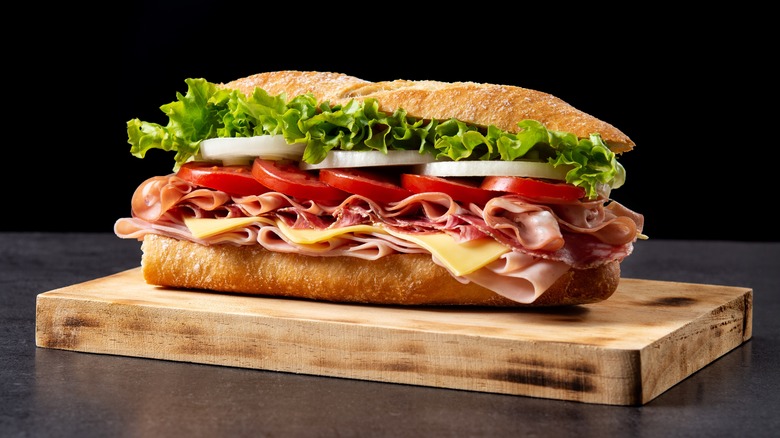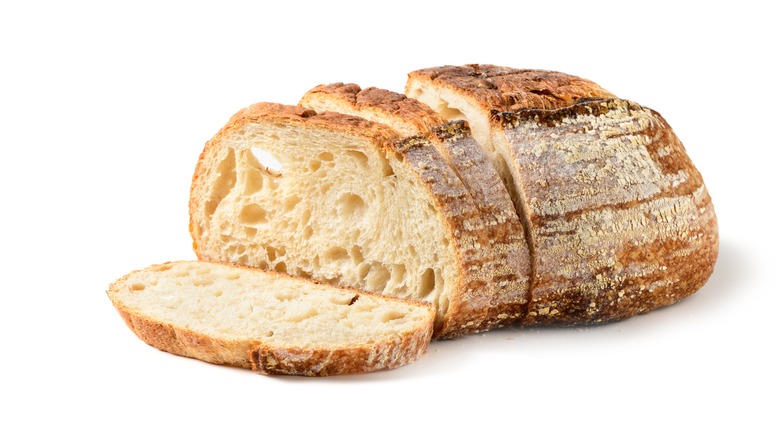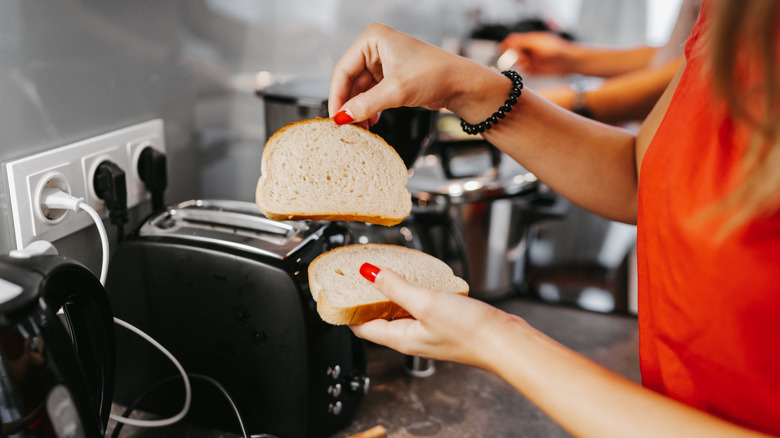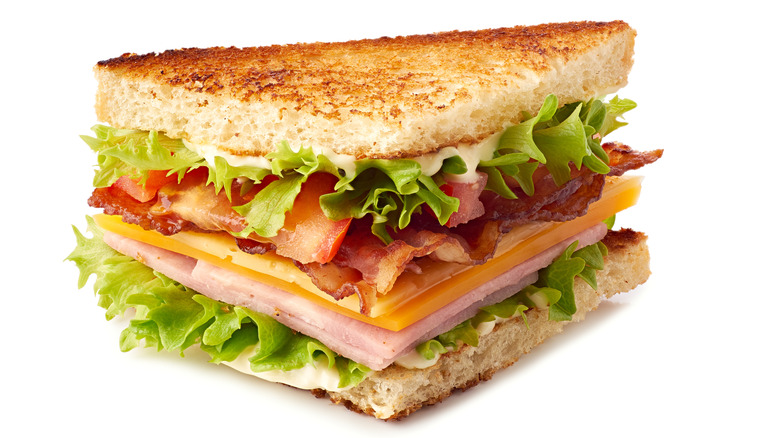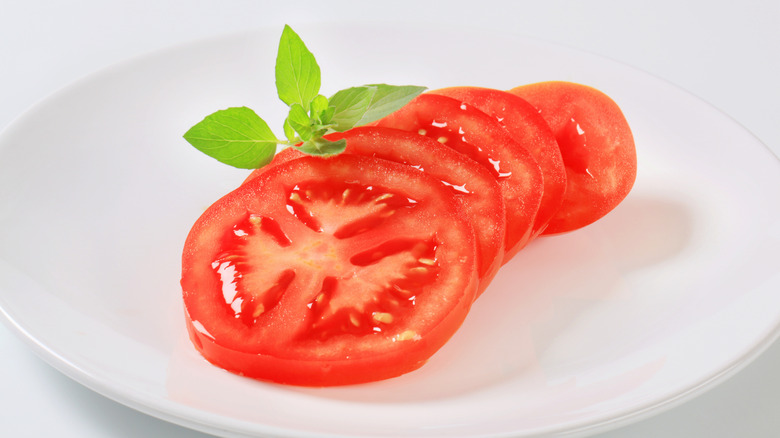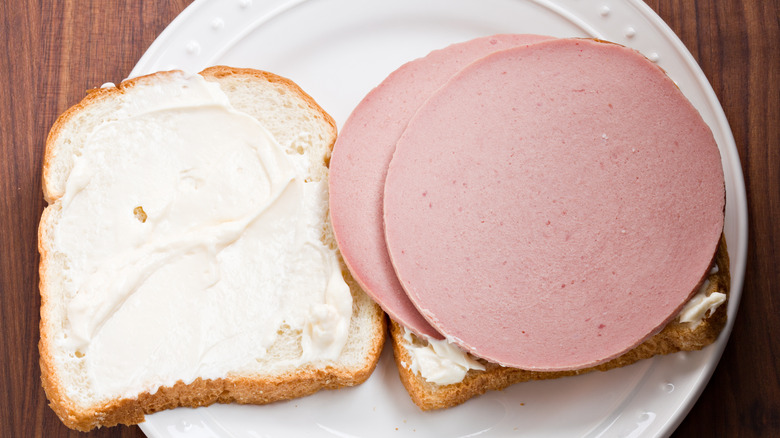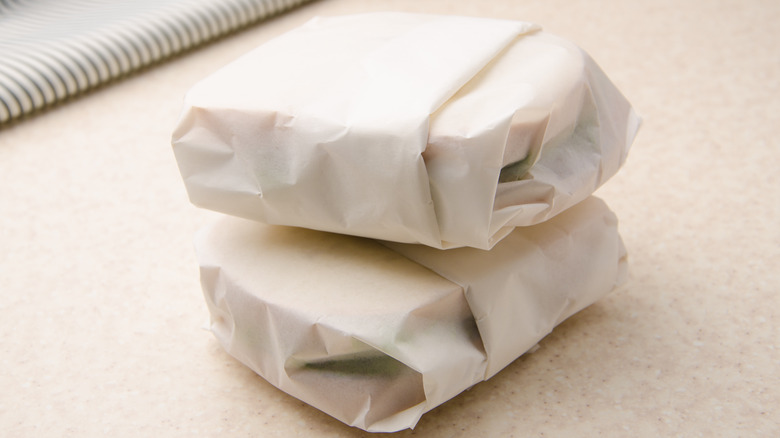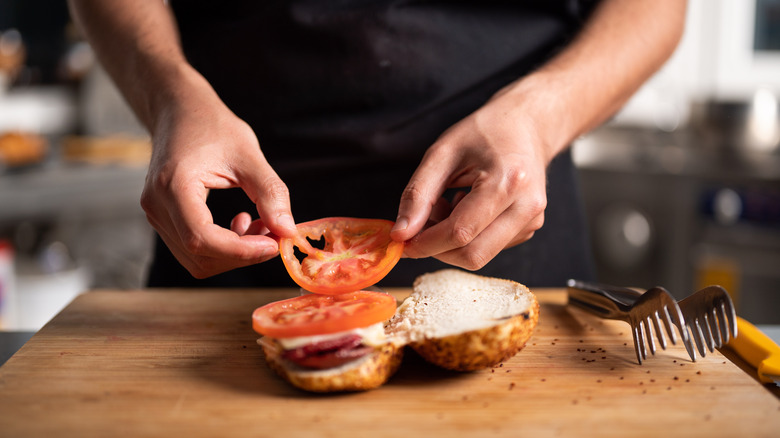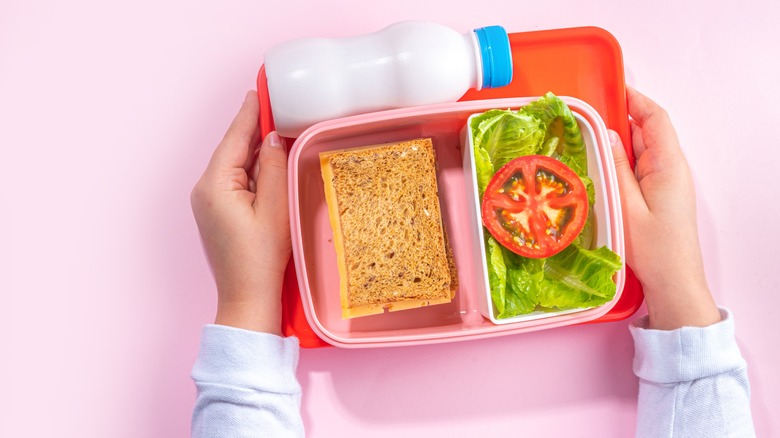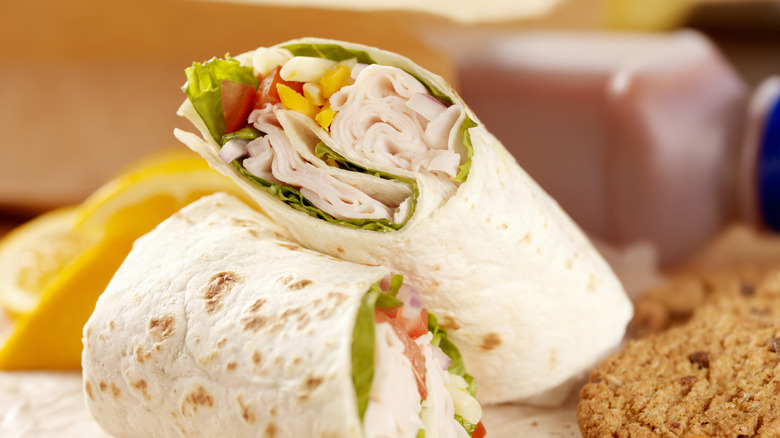Common Mistakes That Are Making Your Sandwich Soggy
The humble — and sometimes not so humble — sandwich dates back to 1762 in England. The credit for inventing the sandwich is usually given to John Montagu, a British statesman and the fourth Earl of Sandwich. Known as a prolific gambler, Montagu would often spend long periods of time at the card table. Not wanting to interrupt his gaming flow, Montagu would ask the cooks for a hand-friendly meal he could eat while gambling. He would be served two slices of bread filled with meat, giving birth to the sandwich we all know and love today. And while a sandwich recipe didn't make an appearance in an American cookbook until 1815, the snack took off in the states during the Great Depression.
Today, sandwiches have become ubiquitous globally thanks to their versatility. From classic combinations like ham and cheese to more exotic options, such as the Monte Cristo, the bready bites offer endless possibilities for customization. While sandwiches are generally straightforward to prepare, there are certain pitfalls that have the potential to dampen even the finest efforts. This is because even small amounts of moisture can transform a slice of bread into a soft and mushy mess and often lead to an undesirable melding of flavors.
While the best way to dodge sodden sandwiches is to eat them immediately after preparation, sometimes this just isn't a possibility. Luckily, a few simple assembly and storage tactics can stop your sandwich from turning into a soggy mess. Keep reading to find out more!
Not selecting the right bread
The cornerstone of a well-crafted sandwich is the right bread. Just as a sturdy foundation supports a towering structure, the right bread serves as the base for the flavors and textures of a sandwich. And while nothing beats the convenience of commercially produced sliced bread, this type of product doesn't fare well when it comes to any kind of moisture. This holds particularly true if you're preparing the sandwiches in advance and don't want them to become soggy over time or during transit.
To stop your sandwich from getting sloppy, it's best to opt for a robust bread that can retain its texture over time, even when filled with damp or warm ingredients. Some of the best sandwich bread options include crusty bread with a crispy exterior such as baguettes, ciabattas, or crusty rolls. Alternatively, you can opt for breads with a sturdy texture such as bagels, rye, or sourdough.
Slicing the bread too thinly and failing to toast it
Since thinner bread slices are prone to becoming soggy faster than their thicker counterparts, always try to buy unsliced bread. This way, you will be able to cut the bread at home yourself with a serrated knife, guaranteeing thick and sturdy slices that are more likely to withstand the effects of moisture.
Once you have cut your bread, pop the slices in the toaster to help the bread maintain its structural integrity once it's loaded up with fillings. Lightly toasting the bread also makes it crispier on the outside yet soft and delicious on the inside, with the outer layer acting as a protective barrier against moisture. Kate O'Malley from Picnic Lifestyle suggests toasting the bread only on one side using a pan or a griddle to keep it moisture-resistant on the interior-facing parts of the sandwich and light and fluffy on the outside. She says this approach works particularly well for BLT sandwiches.
Once you've given your bread a good toasting, it's absolutely essential to allow it ample time to cool down before you start crafting your sandwich. However, instead of laying the slices flat on a plate or countertop as they come back to room temperature, it's best to lean them against a support such as a small rack. This will ensure airflow around the slices and stop steam from dampening your toast.
Using warm fillings or wet ingredients
Warm fillings can ruin a perfectly good sandwich by rendering the bread limp and unappetizing. This is because loading a sandwich up with warm ingredients leads to condensation, which can transform even the most robust bread slices into a soggy disaster. To stop your sandwich from turning into a hot mess, it's best to let freshly cooked fillings, such as bacon, chicken, or egg, cool to room temperature before assembly.
Just like warm ingredients, wet ingredients can also lead to a soggy sandwich. This is why ingredients that are typically stored in jars full of brine, such as peppers, pickles, or olives, should always be dried with a paper towel or a tea towel. This principle also applies to some of the most popular sandwich fillings, including tomatoes and lettuce leaves. When it comes to greens, you can pop them in a salad spinner after rinsing and pat them dry to ensure the removal of any excess water. Alternatively, you can rinse your greens in advance to give them ample time to dry.
Not taking advantage of layering
Making a delicious, sog-free, and aesthetically pleasing sandwich is an art that involves some attention to detail. While we are all guilty of doing this from time to time, haphazardly throwing ingredients between two slices of bread is a recipe for disaster — or rather an unappealing sandwich. Once you've chosen your ingredients, the assembly process becomes critical to constructing a well-crafted sandwich.
There are certain rules that are likely to lead to a sog- and mess-free sandwich with a good balanced of flavors and textures. First, spread a thin layer of butter, mayo, or another condiment on each slice to create a barrier between the bread and the other ingredients (more on this later). Next, use a slice of cheese, meat, or a dry lettuce leaf as a second barrier between moisture-rich ingredients and the bread. Finally, top the sandwich off with wet components such as tomatoes or pickles.
For additional points, avoid stacking tomatoes since this makes them prone to sliding. Instead, spread them out between ingredients that offer friction, such as meat or cheese slices. As a rule of thumb, it's best to place dry and sturdy ingredients at the bottom of a sandwich and delicate — and potentially moist — ingredients on top. This helps to maintain the sandwich's texture and lets gravity take care of any excess moisture by drawing it downward.
Not being careful with the tomatoes
While ripe and juicy tomatoes can elevate a sandwich to the next level, their high moisture content also makes them a sandwich hazard. Over time, tomatoes can even break down cheese slices with their acidity. To keep your sandwich masterpiece dry, you can forego fresh tomatoes altogether and use alternatives such as sun-dried tomatoes or roasted red peppers (be sure to dry them with a paper towel).
If, like us, you love tomatoes, aim to add them to the sandwich right before serving, especially if you're preparing your meal ahead of time. For example, if you're traveling, pop the tomatoes in a Ziploc bag and only add them to the sandwich when you are ready to eat. Another way to prevent tomatoes from making a sandwich soggy is to sprinkle them with a little salt to draw out moisture and gently pat them dry with a paper towel without squeezing or pressing.
Not using butter or olive oil as a barrier
Just like a soggy sandwich, an overly dry sandwich is unlikely to hit that sweet spot. Luckily, a little butter, margarine, or olive oil not only prevents your sandwich from being bone dry but can actually add flavor and stop the transfer of moisture between the sandwich fillings and the bread. It's important not to overdo this — a light coating of butter or a couple of drops of olive oil on each slice is enough to do the trick.
For best results, Phoebe Cornish from Express recommends melting the butter and allowing it to cool before applying it to the bread. If you don't have the time, room-temperature butter will do just fine. In the case of melted butter or olive oil, it's best to apply it evenly with a brush rather than just drizzling it onto the bread, as this can result in an overly greasy sandwich.
Not being smart about condiments
Condiments can transform dry and bland sandwiches by adding layers of flavor, from tangy and creamy to spicy and savory. When it comes to sandwich condiments, there're several schools of thought. Some like to spread their condiments between the more robust ingredients of the sandwich, such as meat and cheese. Others pack condiments separately from the rest of the sandwich and only add them right before serving. Then there are those who swear that a layer of condiment on the bread can stop it from absorbing moisture.
Since not all condiments are created equal, the approach you take should depend on the type of garnish in question. For instance, adding a thin layer of mayo, hummus, cheese spread, pesto, or mustard can create a barrier between the bread and any damp ingredients that could potentially ruin your sandwich. This, however, isn't the case for all condiments. Liquidy dressings such as relish and chutney should be kept away from bread to maintain texture and prevent sogginess.
Not thinking about storage
While regular cling wrap is usually sufficient to keep your sandwiches fresh and contain any food odors until lunchtime, plastic wrapping doesn't absorb moisture. This is where using parchment paper to wrap your sandwiches can be helpful, as the slightly porous nature of parchment paper is excellent for absorbing moisture. Warm or pressed sandwiches, such as paninis, are best wrapped in foil. Notably, you don't need to unwrap the sandwiches from the foil before warming or reheating them in an oven.
Once your sandwiches are securely wrapped, place them in an airtight lunch box. This step guarantees that your sandwiches will maintain their original shape, sparing you the frustration of having to eat a flattened meal. Avoid leaving any unused space in the container since this is likely to displace sandwich ingredients as you go about your day. If the day happens to be particularly hot, it's a good idea to place an ice pack inside your lunch box. Alternatively, freeze a bottle of water or a juice box and pop it inside the container.
While transporting sandwiches in aluminum foil is generally not recommended unless you are planning to warm them up later, one Quora user begs to differ. More specifically, they say that they "use the traditional English way of keeping them fresh," advising, "Wrap them tightly in aluminum foil, chill them for an hour or so in the fridge, [...] and they are perfect to eat at lunchtime."
Not wrapping the sandwich in a paper towel
If you don't have parchment paper on hand, you can cover your sandwiches with regular paper towels (or even toilet paper) before they go into your lunch box, as demonstrated by TikTok user @bornunicornyt. After all, paper towels are just as absorbent — if not more so — than parchment paper. They are also much cheaper.
Not only will this trick prevent your sandwich from becoming moist and spongy by absorbing any excess moisture and protecting the bread from condensation, but it will also keep all your ingredients securely in place during transit. If you're concerned about the paper towel not being strong enough to prevent your sandwiches from falling apart, you can also wrap them in cling wrap or even secure them with a string. One Reddit user swears by the paper towel method when it comes to keeping their Subway sandwiches from becoming soggy, although their storage method utilizes both paper towels and aluminum foil.
Making the sandwich too far in advance
There's nothing quite like a freshly prepared sandwich. Crisp lettuce, juicy tomatoes, succulent meats, and creamy spreads nestled in between two slices of newly baked bread can be heaven for the taste buds. Unfortunately, there are times when we have no choice but to assemble our sandwiches ahead of time. And no matter how carefully we prepare them, if we leave sandwiches out long enough, they are bound to become soggy, lose their flavor, or even turn bad.
If you absolutely must prepare your sandwiches well in advance, be sure to wrap them and place them in an airtight container before storing them in the refrigerator. Once out of the fridge, sandwiches can deteriorate rapidly. While there's more leeway with sandwiches that don't contain protein, meat sandwiches are an entirely different story. According to the U.S. Department of Agriculture, perishables such as meat and poultry that have been left unrefrigerated for longer than two hours may no longer be safe to eat due to bacterial growth. This time period is reduced to one hour if the meat is exposed to temperatures above 90 degrees Fahrenheit.
To keep your sandwiches fresh longer, invest in an insulated sandwich bag. These are specifically designed to keep your meals warm or cool for hours at a time. Unlike plastic wraps and parchment paper, sandwich bags can be washed and reused time and time again, which isn't just handy but also great for the environment.
Not packing the fillings and bread separately
While many of us choose to prepare our lunch in advance, some take their sandwich-making seriously enough to package each ingredient separately and assemble their sandwich just before serving. In addition to preserving the integrity of each flavor, this method also safeguards the bread from absorbing any excess moisture. This strategy can be particularly useful if you're planning a picnic with a group since it lets participants customize their own mess-free sandwich.
Packing individual sandwich components needn't be a hassle. Mealprep offers plenty of tips that should make the job a piece of cake. Start by selecting an airtight container that's just large enough to fit your bread slices and place them on the bottom. Stretch a piece of cling wrap over the bread, making sure that its edges extend beyond the sides of the container. Next, place your sandwich ingredients on top of the wrap, adding additional layers of plastic wrap as necessary. It goes without saying that you should keep your condiments separate. Finally, close the container with a lid. Of course, you can always use multiple containers for different sandwich ingredients if you have enough space in your bag.
There is another way to prevent your sandwich from getting soggy in transit without wasting too much time on assembly later in the day. The solution is to partially build your sandwich at home using dry ingredients, and then incorporate additional fillings like tomatoes, tuna, or eggs when it's time to enjoy your lunch.
Not using bread substitutes
While the sandwiches we know and love consist of bread and a variety of fillings, there are many other takes on the snack that will never turn it into a soggy mess. Most notably, vegetables offer a practical and health-conscious substitution for bread. This is because store-bought white bread is often filled with refined carbohydrates, added sugars, gluten, and excess calories.
Chard, kale, cabbage, and collard leaves are usually robust and pliable enough to hold sandwich fillings wrap-style. Best of all, they will never turn soggy. Soft tortillas can also be wrapped around your favorite sandwich ingredients. And while they can become damp with time, tortillas are much better at withstanding moisture than regular bread. For something slightly different, you turn wrap-style sandwiches into tasty finger food by cutting them into convenient bite-sized pieces.
Cooked or grilled vegetable slices can also make a great bread replacement. Some veggies that lend themselves specifically well as a base for sandwich fillings include sweet potatoes, eggplant, bell peppers, and portobello mushrooms. Alternatively, you can place your sandwich fillings in between two rice cakes or wrap them in edible seaweed known as nori.
